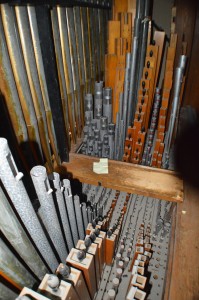
The interior of the 1912 Moller organ at St. Joseph's Catholic Church, Shelbyville, IN
I am a “cat person.” And one thing I have learned about cats is that they are very stoic. A kitty can be in terrible pain, and show no outward sign, unless you are very attuned to its moods and habits. Sometimes, by the time they are obviously sick and hurting, they are in real crisis.
Pipe organs are similar in this regard. The sound of the pipes themselves does not change appreciably, even though the decades have taken a heavy toll on the perishable parts of the instrument. Mechanically, the organ can be at “death’s door,” and yet still sound magnificent to the casual listener. This is especially true if the organist knows his instrument, and knows how to cover deficiencies and avoid the “klinkers.” So it was at St. Joseph’s Catholic Church in Shelbyville, IN. That the 1912 Möller organ was failing became obvious nearly a decade ago to the musicians that played it . And how not? Although the organ had been electrified in the 1970s, it had never had a major renovation. It had functioned, Sunday after Sunday, and had seen several generations of St. Joseph’s parishoners through their long lives.
Yet, even though it was nearly non-functional, it somehow continued to serve the parish with its rich, glorious sound.
When the Möller organ first spoke into St. Joseph’s beautiful, consecrated space, William Howard Taft was President, although Theodore Roosevelt desperately wanted the job back. The doughboys of World War I were still doing their school lessons. That year, the great ship Titanic, went to a watery grave through a fatal combination of natural forces and human hubris. Pius X was pope, and in 1903 promulgated a moto proprio entitled, Tra le Sollecitudini, that included instructions on sacred music. In those instructions, the use of piano in Roman Catholic worship was “forbidden,” (along with other “frivolous instruments”), and the organ was recognized as the proper instrument to accompany sacred worship.
During the Möller’s century-long life, the world changed. Worship changed. Organs also changed. Many Christian churches, Catholic and Protestant alike, remained “traditional,” while other took a more populist approach, often emulating pop music sounds in an attempt to inspire the faithful. Pipe organs designed in American during the mid-century (a time known as the “organ reform movement”), abandoned the rich warm sounds of earlier times for a more icy, transparent sound that many organists approved. Now, organs have come full-circle as well, with a new interest in colorful Romantic sounds, such as are found in St. Joseph’s venerable instrument.
Costs also have changed. They call it “sticker shock.” To anyone who hasn’t bought a house, or a car, or milk and butter for a number of years, today’s costs seem extravagant. Imagine the church, then, that hasn’t been in the market for a pipe organ for over a century!
So, as the Möller began to fail, Curtis Davies, the principal organist at St. Joseph’s, began to look toward the day when the church’s organ problems could be finally resolved, either in a new instrument, or in new life for the “old girl,” as the Möller was affectionately known.
Curtis is a very patient man. Fortunately.
Tune in again to see what happened next!

